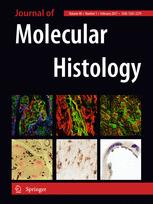Journal of Molecular Histology

http://link.springer.com/journal/10735
ISSN: 1567-2379 (Print) 1567-2387 (Online)
This journal was previously published under other titles (view Journal History)
Description
The Journal of Molecular Histology publishes 6 times a year full-length original research papers, review articles, short communications and letters to the editors. Coverage includes studies describing novel cellular or ultrastructural distributions of molecules which provide insight into biochemical or physiological function, development, histological structure and disease processes. Among the techniques addressed are histochemistry, immunohistochemistry, in situ hybridization, receptor binding, autoradiography, image capture and processing, and reporter molecules as well as state-of-the-art visualization techniques.
Areas of research include: Cell-Cell and Cell-Matrix Interactions; Connective Tissues; Development and Disease; Neuroscience. The Journal of Molecular Histology does not consider manuscripts dealing with the application of immunological or other probes on non-standard laboratory animal models unless the results are clearly of significant and general biological importance.
hide
****
Cite this article as:Manocha, S.L., Warner, H. & Olkowski, Z.L. Histochem J (1975) 7: 343. doi:10.1007/BF01007019
Synopsis
Morphological and cytochemical studies on the squirrel monkey have been made after maintaining the subjects on pure distilled water and fluoridated distilled water for 18 months with the objective of determining the effect of fluoride on the activity of some hydrolytic and oxidative enzymes in the kidney, liver and nervous system. Daily water intake by individual animals was measured over the final 10 months of the animal’s exposure to 0,1 and 5 ppm fluoride. Water consumption was considerably higher in the animals on higher fluoride intake. Whereas the nervous system remained totally unaffected by this experimental procedure, the liver showed a slightly enhanced activity of Krebs citric acid cycle enzymes. The kidneys, however, showed significant cytochemical changes, especially in the animals on 5 ppm fluoride intake in their drinking water. In these animals, the glomeruli showed an increase in the activity of acid phosphatase and the enzymes belonging to the citric acid cycle and the pentose shunt, whereas lactate dehydrogenase, a representative of the anaerobic glycolytic pathway, remained unchanged or only slightly changed. These observations suggest that fluoride in concentrations as low as 5 ppm interferes to some extent with the intracellular metabolism of the excretory system.
http://link.springer.com/article/10.1007/BF01007019




http://citeweb.info/19950304822